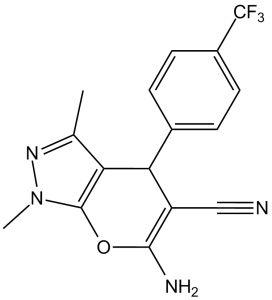BQU57, a derivative of RBC8, is a novel and selective GTPase Ral inhibitor relative to the GTPases Ras and RhoA. RBC8 is a derivative of BQU57. It inhibits tumor xenograft growth and demonstrates selectivity for Ral in comparison to Ras and RhoA GTPases. Isothermal titration calorimetry (ITC) was used to measure the dissociation constant (Kd) of 7.760.6 mM for the binding of BQU57 to RalB–GDP. With a Kd value of 4.761.5 mM, it was comparable to the surface plasmon resonance (SPR) results. The colony formation of the Ral-dependent lines H2122 and H358 in soft agar can be effectively inhibited by RBC8 or BQU57, but not by H460 or Calu-6.
Physicochemical Properties
| Molecular Formula | C16H13F3N4O | |
| Molecular Weight | 334.1 | |
| Exact Mass | 334.104 | |
| Elemental Analysis | C, 57.49; H, 3.92; F, 17.05; N, 16.76; O, 4.79 | |
| CAS # | 1637739-82-2 | |
| Related CAS # |
|
|
| PubChem CID | 77845606 | |
| Appearance | Light yellow to yellow solid powder | |
| Density | 1.4±0.1 g/cm3 | |
| Boiling Point | 493.4±45.0 °C at 760 mmHg | |
| Flash Point | 252.2±28.7 °C | |
| Vapour Pressure | 0.0±1.3 mmHg at 25°C | |
| Index of Refraction | 1.610 | |
| LogP | 2.33 | |
| Hydrogen Bond Donor Count | 1 | |
| Hydrogen Bond Acceptor Count | 7 | |
| Rotatable Bond Count | 1 | |
| Heavy Atom Count | 24 | |
| Complexity | 574 | |
| Defined Atom Stereocenter Count | 0 | |
| SMILES | NC1=C(C#N)C(C(C(C)=NN2C)=C2O1)C3=CC=C(C(F)(F)F)C=C3 |
|
| InChi Key | IJCMHHSFXFMZAI-UHFFFAOYSA-N | |
| InChi Code | InChI=1S/C16H13F3N4O/c1-8-12-13(9-3-5-10(6-4-9)16(17,18)19)11(7-20)14(21)24-15(12)23(2)22-8/h3-6,13H,21H2,1-2H3 | |
| Chemical Name | 6-amino-1,3-dimethyl-4-[4-(trifluoromethyl)phenyl]-4H-pyrano[2,3-c]pyrazole-5-carbonitrile | |
| Synonyms |
|
|
| HS Tariff Code | 2934.99.9001 | |
| Storage |
Powder-20°C 3 years 4°C 2 years In solvent -80°C 6 months -20°C 1 month |
|
| Shipping Condition | Room temperature (This product is stable at ambient temperature for a few days during ordinary shipping and time spent in Customs) |
Biological Activity
| Targets | GTPase Ral | |
| ln Vitro |
|
|
| ln Vivo |
|
|
| Enzyme Assay | This assay used J82 human bladder cancer cells that stably expressed Flag-tagged RalA. The Flag epitope tag greatly increased the sensitivity and dynamic range of the assay compared with using Ral-specific antibodies for detection. Cells were treated with each of the 88 compounds (tested at 50 mM), and then extracts were prepared. The binding of Flag–RalA to recombinant RALBP1 that had been immobilized in 96-well plates was quantified. In this assay, RalA binding reflects Ral’s GTP loading and capacity for effector activation. | |
| Cell Assay | The compounds are tested for their ability to inhibit human lung cancer cell growth in soft agar medium without requiring anchorage. Seeding of cells into 6-well plates with a base layer of 2.0 mL of 1% low-melting-point agarose and 3.0 mL of 0.4% low-melting-point agarose containing different drug concentrations results in 15,000 cells per well. Under a microscope, colonies are counted two to four weeks (depending on the cell line) after the cells are incubated and stained with 1.0 mg/mL Nitro Blue Tetrazolium. The drug concentration at which the number of colonies was reduced by 50% when compared to the DMSO-treated control is known as the IC50 value. After 48 hours, the soft agar colony formation assay is performed on the cells. | |
| Animal Protocol |
Mice bearing human lung H2122 tumors 50 mg/kg i.p. |
|
| References |
[1]. Discovery and characterization of small molecules that target the GTPase Ral. Nature. 2014 Nov 20;515(7527):443-447. |
Solubility Data
| Solubility (In Vitro) |
|
|||
| Solubility (In Vivo) |
Solubility in Formulation 1: ≥ 2.5 mg/mL (7.48 mM) (saturation unknown) in 10% DMSO + 40% PEG300 + 5% Tween80 + 45% Saline (add these co-solvents sequentially from left to right, and one by one), clear solution. For example, if 1 mL of working solution is to be prepared, you can add 100 μL of 25.0 mg/mL clear DMSO stock solution to 400 μL PEG300 and mix evenly; then add 50 μL Tween-80 to the above solution and mix evenly; then add 450 μL normal saline to adjust the volume to 1 mL. Preparation of saline: Dissolve 0.9 g of sodium chloride in 100 mL ddH₂ O to obtain a clear solution. Solubility in Formulation 2: ≥ 2.5 mg/mL (7.48 mM) (saturation unknown) in 10% DMSO + 90% Corn Oil (add these co-solvents sequentially from left to right, and one by one), clear solution. For example, if 1 mL of working solution is to be prepared, you can add 100 μL of 25.0 mg/mL clear DMSO stock solution to 900 μL of corn oil and mix evenly. (Please use freshly prepared in vivo formulations for optimal results.) |
| Preparing Stock Solutions | 1 mg | 5 mg | 10 mg | |
| 1 mM | 2.9931 mL | 14.9656 mL | 29.9312 mL | |
| 5 mM | 0.5986 mL | 2.9931 mL | 5.9862 mL | |
| 10 mM | 0.2993 mL | 1.4966 mL | 2.9931 mL |
